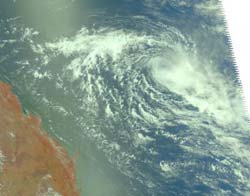NASA's Aqua Satellite sees Tropical Depression Anthony heading toward Australia

NASA\'s Aqua Satellite captured this visible image on Jan. 26 at 03:23 UTC of a now weakened Tropical Depression Anthony as it continues to weaken in the South Pacific Ocean. Eastern Australia can be seen on the left side of this image. Credit: NASA JPL, Ed Olsen<br>
The Atmospheric Infrared Sounder (AIRS) instrument that flies aboard NASA's Aqua satellite captured a visible image on Jan. 26 at 03:23 UTC of Tropical Depression Anthony in the South Pacific Ocean. The image revealed a cloud-filled center of the storm.
At 0600 UTC (1 a.m. EST) on January 26, Anthony had progressed west and was now about 455 nautical miles west-northwest of Nomeau, New Caledonia. That places Anthony's center near 19.2 South and 159.1 East. Maximum sustained surface winds are estimated at 25 to 30 knots (28 mph/46 km/hr to 34 mph/55 km/hr) meaning that Anthony is still at tropical depression status.
The infrared imagery from the AIRS instrument showed a well-defined low level circulation center, although dry air is now wrapping into Anthony's northern quadrant. Dry air saps the moisture that creates the thunderstorms that power a tropical cyclone. Generally, the storm's convection (rapidly rising air that creates those thunderstorms) is weak throughout the storm, and only isolated strong areas of convection appear in the southeastern quadrant. That may change in the next day or two, however, as Anthony moves into an area more conducive to maintaining a tropical cyclone.
Vertical wind shear (winds that can weaken a tropical cyclone) has lessened and sea surface temperatures are warm enough to sustain and strengthen a tropical cyclone (between 28 and 30 Celsius/82 and 86 Fahrenheit). Computer forecast models have shown forecasters at the Joint Typhoon Warning Center that as the system tracks westward toward Australia, there is a fair chance that Anthony will regenerate or re-strengthen in the next 24-36 hours. Forecasters in Queensland, Australia will be watching Anthony very closely.
NASA's Hurricane page: www.nasa.gov/hurricane
Media Contact
All latest news from the category: Earth Sciences
Earth Sciences (also referred to as Geosciences), which deals with basic issues surrounding our planet, plays a vital role in the area of energy and raw materials supply.
Earth Sciences comprises subjects such as geology, geography, geological informatics, paleontology, mineralogy, petrography, crystallography, geophysics, geodesy, glaciology, cartography, photogrammetry, meteorology and seismology, early-warning systems, earthquake research and polar research.
Newest articles

Organic matter on Mars was formed from atmospheric formaldehyde
Although Mars is currently a cold, dry planet, geological evidence suggests that liquid water existed there around 3 to 4 billion years ago. Where there is water, there is usually…

Engineers 3D print sturdy glass bricks for building structures
The interlocking bricks, which can be repurposed many times over, can withstand similar pressures as their concrete counterparts. What if construction materials could be put together and taken apart as…

New organic thermoelectric device
… that can harvest energy at room temperature. Researchers have succeeded in developing a framework for organic thermoelectric power generation from ambient temperature and without a temperature gradient. Researchers have…















